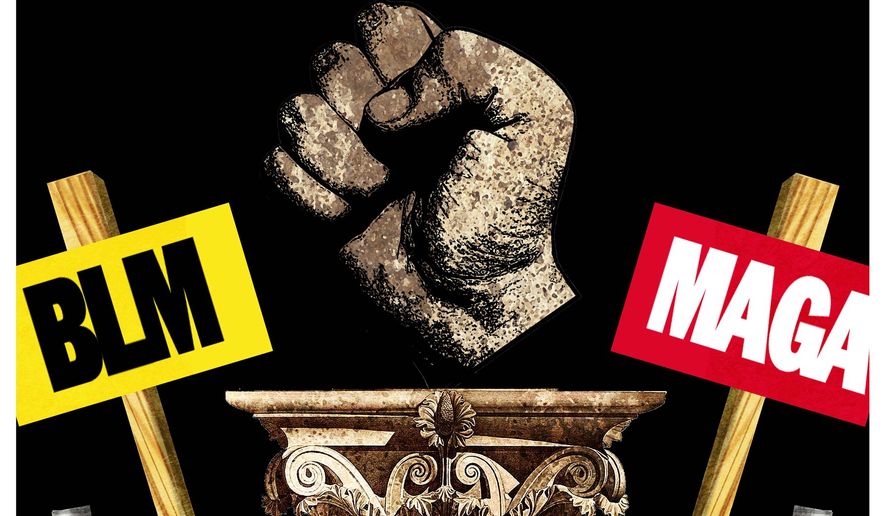OPINION:
In the wake of protesters (rioters?) breaking windows and rumbling through the Capitol on Jan. 6, many have rightly noted a certain amount of hypocrisy threading through both the news coverage of and the rhetoric surrounding the incident.
Neither the Democrats nor the legacy media appeared as agitated about the “peaceful protests” this summer, which were more destructive, more lethal and involved at least as many federal buildings as did the riot (protest?) on Jan. 6.
That’s fine. Everyone chooses to emphasize different things in life. But no one has emphasized or even mentioned the substantial similarities and the relatively modest differences between the Trump crew and Team Black Lives Matter.
At their core, they are bound together by grievances against the state and the polity it represents.
In each instance, the aggrieved party believes — with some justification — that it has been marginalized by the government or by the larger society or both. The banning of President Trump from Twitter and Facebook and the immediate shunning of Parler won’t help any of that.
Team Trump wants the state to stop damaging them through trade deals, immigration and a general drift toward a society that it views as unrecognizable and that rewards the wrong sorts of things.
Team BLM and its sympathizers believe that the state – as expressed through law enforcement, housing and most especially education — is indifferent to it at best and intentionally destructive at worst. At the moment, they want the state to do “better,” which seems to mean “more.” They eventually will discover that it is better if the state involves itself less in their lives.
Team Trump is farther down the path toward concluding that they have been voting for the wrong kinds of people for years. BLM sympathizers still need a few years to fully realize that they, too, have been voting for the wrong people for generations.
In each set of protests (and here’s where there can be legitimate differences), the parties have been treated more or less with the same sort of laissez faire approach by law enforcement. In the summer, protesters were not gunned down and few were arrested. At the Capitol, the protesters were not gunned down and all but a handful were not arrested.
Both groups also share a sense that some of their problems can be solved by government.
The federal government doesn’t solve problems. Occasionally, government ameliorates a problem by throwing cash at it, or rearranging organizational responsibilities, or killing a nation’s enemies, but for the most part it doesn’t solve problems. People do. By inventing things, or creating new ways of doing things, or – as is required here – by changing hearts and minds, people solve problems.
Government does, however, create problems. It is here that the Trump crew is closest to correct. Their grievances center on trade, immigration and, when they are coherent, the size and scope of government (pay no mind to the fact that Mr. Trump expanded both the government and the deficit at some of the most impressive rates in history).
BLM is asking for something – to be considered by their fellow citizens as true equals — that no government can give. Only individual consciences and God can make that happen.
If there is systemic racism, which is not yet a fact in evidence, the government is unlikely to solve it.
Finally, with respect to both teams’ interactions with the government – whether it be law enforcement, administration of justice, housing, immigration, trade, or – most pointedly — education, both groups find themselves on the wrong end of a government that ranges from diffident to hostile.
Indeed, they both now fully understand that government – which in all places and at all times claims a monopoly on legitimate violence – only acts decisively when you start damaging their property. In the week since the rumble in the Capitol, the federal government has managed to assemble and deploy the equivalent of almost two armored divisions in Washington. It has become Baghdad on the Potomac, complete with its own Green Zone.
That’s one other, final and unfortunate similarity between the two groups. To both, the government is usually better at offering force than understanding.
• Michael McKenna, a columnist for The Washington Times, is the president of MWR Strategies. He was most recently a deputy assistant to the president and deputy director of the Office of Legislative Affairs at the White House.




Please read our comment policy before commenting.